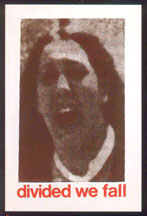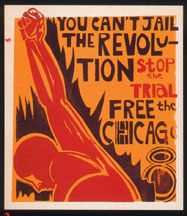1. Anon. (May 1970 UC/Berkeley workshop) 1970
Divided we fall 24x19 serigraph
The newsphoto of the young woman transfixed in anguish above the bodies of the demonstrators murdered at Kent State was seared indelibly into the nation's consciousness. A hundred posters made use of the image. This was perhaps the sparest, concentrating the instant of shock in its survivor, her face a mute code for the gulf of betrayal. The greatly-enlarged screen dots of the newsphoto perpetuate the immediacy of the event; the legend records our vertigo.
2. Anon. 1969
You can't jail the revolution 24.2x20 serigraph
Urging support for leaders of demonstrations at the 1968 Democratic Convention, the poster quotes a notorious news-photo of U.S. sprinters giving the Black Power salute on the Olympic victory stand. The image then evoked the lone Black defendant, bound and gagged in court. In retrospect, it reflects the impact of the politicization of sports, and the Left's fetishism of Black militance.
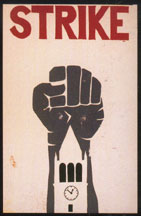
3. D.S. (UC/Berkeley Third World Strike workshop) 1969
STRIKE! 34.5x23 serigraph
The earliest collective workshops of the Bay Area renaissance crystallized in campus struggles. Here the symbol of Student Power rises above the Berkeley campus's ivory tower -- signifying not simply a revolt in support of minority student demands, but transformation of the institution, a re-dedication of its social enterprise.
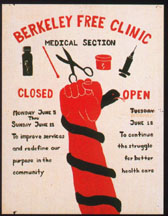
4. Anon. 1972
Berkeley Free Clinic 22.5x17.5 serigraph
The poster announces a dual transition. A paramedic corps born in street demonstrations reorganizes as an activist clinic for the community, as the thrust and iconography of the New Left evolve. The Fist of resistance has not yet opened to grasp the tools above it; the climbing snake still reminds us as much of Don't tread on me as of the caduceus.
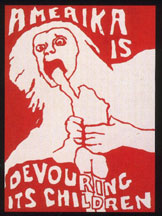
5. Anon. (May 1970 UC/Berkeley workshop) 1970
Amerika is devouring its children 22x15
serigraph on computer paper
After the Cambodia bombing and murders at Kent State and Augusta, public silkscreen workshops organized on dozens of campuses, producing at least 450 designs at Berkeley alone. Here an image from Goya, of the god Kronos at terrible feast, records the primordial feeling of the moment.
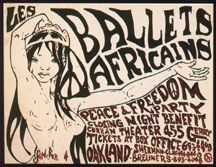
6. Anon. 1968
Les Ballets Africains 17x22 serigraph
Though the lettering and image reflect the influence of rock-dance posters, the figure's political content was intrinsic -- for reclaiming African heritage was already a theme of the Black movement, and the PFP presented itself proudly as an inter-racial party. The deeper content became explicit only as the feminist movement developed. A year later, the naked female form was no longer acceptable as advertisement for progressive politics.
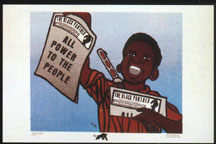
7. Emory (Douglas), Black Panther Party c.1969
All Power to the People! 14.9x22.7 offset on newsprint
A provocative newsboy announces the power not only of the press but of the image. The paper was the Black Panthers' main medium of public outreach, and spread hundreds of Emory's bold icons across the nation.
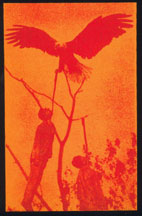
8. Bruce Kaiper, Media Project 1970
"The Predator" 22x14.8 serigraph
Using C.I.A. and Audobon Society photos shot through a mezzotint filter, Kaiper's graphic metaphor for the U.S. presence in Vietnam helped introduce local postermakers to John Heartfield's mode of political photomontage. The image reminds us that our national symbol is a carrion scavanger. Its colors conjure the heats of napalm; the figures also evoke Southern lynchings, emphasizing that people of color were the target in Vietnam.
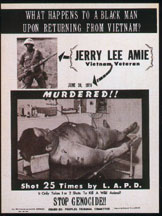
9. (Vermont S. Galloway) 1970
What happens to a Black man...? 24x17.5 offset
The War comes home to the Black community, in an image that could well have come from current shootouts in ghettoes, where the war's legacy has written half the young men out of the economy.
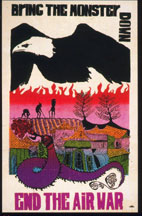
10. Anon. (East Bay Media) 1972
Bring the monster down 35x23 serigraph
Usually shown as victims or fighters, here the Vietnamese appear in sweet-hatted innocence within their culture, as a new poster workshop takes root in the community. The eagle's dark calliagraph encodes not only the U.S. "mission" but the massiveness of the bombing; the dragon of resistance swells underground, igniting the land.
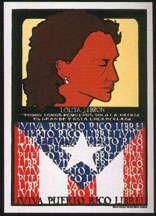
11. (Linda Lucero), La Raza Silkscreen Center 1975
Lolita Lebron 28.5x22.5 serigraph
After 20 years in prison, the Puerto Rican nationalist's face is dignified in endurance and in its formal setting, above a flag whose meaning is transformed from the subjugation encoded in its mimicry of the U.S. flag, by the cry of a free nation written as upon a cell wall in the endless days. The dark frame, the stripes turned bars, make her seem to whisper from her cell window, "We're all small, only our homeland is great, and it's in prison." Lucero's design marks the heyday of the first great Chicano workshop, and direct Cuban influence.
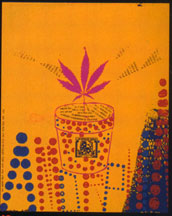
12. (Michael Bell), Hound Dog Press 1971
Amorphia 28.5x22.5 serigraph
Around a vegetable Fist, the image is at play. Psychedelic dots render the name of the group working to legalize marijuana. The "pot" is in the pot, mulched by scraps evoking the darting of the stoned mind and the related literary technique of scissors-collage. Only the pack of rolling-papers sold to benefit the campaign is in sharp focus, as if to say, "These hippies mean business."
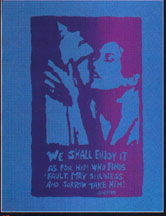
13. Anon. mid-1970s
We shall enjoy it 26x20 serigraph with silver glitter
In a night sparkling with sensation, their delicious restraint suggests abandon. Before the mutations of political consciousness in the late 1960s, this would hardly have been recognizable as a political poster. The soft message it embodies is also of the medium's own mutation; for the traditional political poster was not designed for use inside either the home or the private spirit.
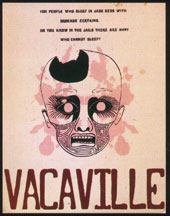
14. Anon. late 1970s
Vacaville 22.5x17.5 serigraph
The blank eyes reflect the absent self. The blobby phantoms of the mind escaping are also the symmetrical stigmata of the Rorschach Blot test, the analytic armament used to certify confinement, stamped across the face. Vacaville is a state prison for the criminally insane. The poster tacitly announces the expansion of the political domain to include "madness."
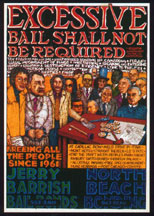
15. (Hunter and Pollack) 1974
Excessive bail shall not be required 18.5x27 offset
Adapting its format from underground comix, the poster celebrates a special role in Movement politics. The tolerant bondsmen offer bail for Nixon, before the cast of the sordid Watergate drama. Above the cartoon, a list of his crimes; below it a list of their credentials, recording support for a remarkable array of seminal political causes.
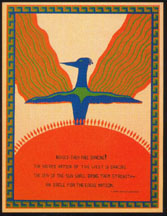
16. Anon. c.1978?
Behold -- they are dancing! 23x17.5 serigraph
What dances in this Native American work dances as distinctively in each other stream of ethnic and racial activism, as the images of its heritage are restored to its people and the world.
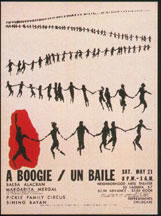
17. (Ron Weil) Gonna Rise Again Graphics 1977
A Boogie/Un Baile 26x20 serigraph
Emerging from tribal prehistory, the dancers' energetic jags evoke the picket line, the Long March, the ragged semblance of gathering community, led by the glad Fist of rebellion.
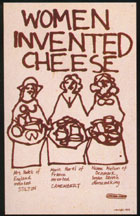
18. Deborah Green 1977
Women Invented Cheese 17x11 offset
Every people -- whether racial, ethnic, or metaphorical -- reinvents its heritage through posters. The sketchy historical data here support a claim dating from the Neolithic.
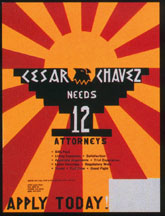
19. Anon., La Raza Graphics Center c. 1980
Cesar Chavez needs 12 22.5x17.5 serigraph
Aloft in poster skies since 1966, the symbol of the UFW thunderbird was rarely figured. Here it spreads its wings against a La Raza sun to advertise unusual need, with a personalismo appeal promising dirt wages and "the good fight." A pad of applications fits the lower corner. The poster is an example not simply of functional grace but of function itself -- for how else beyond word of mouth could such specialists be recruited on short notice?
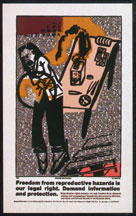
Freedom from reproductive hazards 32x20 serigraph
A deadly genie rises from the reagent-pot of piecework industry in Silicon Valley, to wreak vital damage. Minkler's cartoon is a graffitum of anguish scrawled against the precise, dispassionate substrate of our technolgical society's chemical dependency, translating its meaning. As a visual ground, the dense roster of agents is neutral yet energetic, pulling us to scan its arcane names for the scattered, familiar terms that say danger's everywhere. The woman's image, suggesting an Asian immigrant, is the Oppressed Worker in new circumstance and danger -- and new political context as well, for the poster directs feminists and environmentalists to an emergent front of workforce struggle.
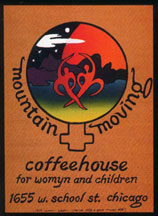
21. Anon., [Chicago] Women's Graphics Collective 1979
Mountain Moving Coffeehouse 24.1x18 serigraph
CWGC's bold designs predominated in women's centers across the U.S. through the 1970s, working to coordinate movement consciousness. Here the workshop serves a local effort, with a graceful image politicized by its frame and the text beneath.
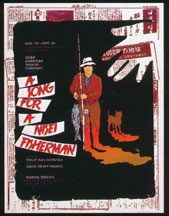
22. Hideo Yoshida (Japantown Art & Media) 1980
A song for a Nisei fisherman 23.1x17.5 serigraph
Someone's uncle, perhaps, restored to a community re-learning its heritage. The newsprint is more than a textural ground. It was fish-wrap, to a people who ate fish most days; and also a vital vehicle of cultural conservation during the decades before a new generation's reaffirmation. Here it frames the cameo of memory as a cultural project, offered by a bold hand to the broader community in a theater far from Japantown -- offering also a rare glimpse of the craft of Asian-American postermakers, seldom seen outside their home communities.
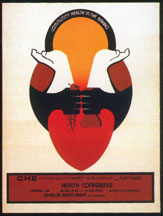
23. (Malaquias Montoya, Taller de Artes Graficas) 1977
Community health in the barrio 23x17.5 serigraph
Within an open mouth of announcement, the Fists of material resistance grasp symbols of ancient and modern medicine above the community's heart, and arch transformed into the spiritual hands of collective power, upholding the crown of health above the dawn. Recalling the great Mexican muralists, the design integrates references to changing perspectives in health care, community development, and political practice -- offering a synoptic advertisement for the clinic, and a glimpse of the artist, legendary as a teacher and as master of the overnight rush job, here in his formal power.
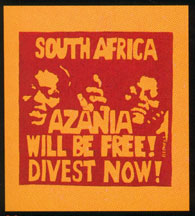
24. Anon. (Fireworks) 1985
South Africa 13x12 serigraph
San Francisco's Fireworks collective organized a workshop on the administration building's steps during the long anti-apartheid encampment at Berkeley. Though police confiscated its equipment twice, it kept producing vibrant work.
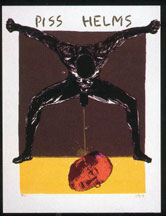
25. Jos Sances 1990
Piss Helms 45.3x34 serigraph
Recycling the most notorious images targeted by the NEA art witch-hunt, Sances targets its Congressional leader in return, in a manner as appropriate as raw. When Jesse Helms is forgotten, this poster will stand as a self-portrait of a master at play in his chosen medium.
